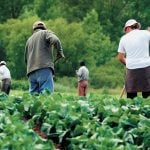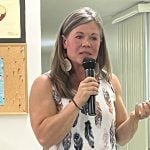Tea – relax and take a sip
As a child I can remember tasting tea from my grandmother’s cup and thinking that I was just like the grownups. I would pretend it was so good, but to my developing taste buds tea was quite bitter.
When I was 12 years old, a family friend intrigued me by promising to read the tea leaves at the bottom of my cup. Tea was not so bad after all. It was not until I went to university and lived with my grandparents that I truly became a “tea granny,” a title my mother gave me.
Read Also

Worrisome drop in grain prices
Prices had been softening for most of the previous month, but heading into the Labour Day long weekend, the price drops were startling.
My grandparents made a pot of tea to complete their meals. At first it seemed strange, but soon it was part of the routine. It gave us a time to relax, get to know each other and for my grandfather to shape my mind when it came to important things like politics, religion and saving money. Tea time always took longer when I disagreed with him.
Many legends surround the discovery of tea. The oldest known is Chinese and dates back to 2737 B.C. The Chinese boiled their water before drinking it, but found boiled water alone just was not tasty. Emperor Shen Nung was drinking boiled water when the leaves from a wild tea bush fell into the steaming liquid – today’s popular beverage was discovered.
By the ninth century, the drinking of tea had spread to Japan and the Japanese began growing their own tea.
The Dutch were among the first people in Europe to drink tea. Their ships imported tea to western Europe in the late 1600s, and soon spread to Britain where large quantities were imported to meet demands.
Tea travelled with pioneers who settled in North America. Every wagon train had a large supply of tea, perhaps to comfort these people as their new lives began. The Hudson Bay Company was the first to import tea to Canada in 1716. It took more than a year to arrive, but Canadians have been tea lovers ever since.
Drinking tea is definitely a social custom, as it sparks good conversation. Anna, the seventh duchess of Bedford, first initiated afternoon tea. She invited guests for a cup of tea and some sweets in the afternoon to fill the long gap between breakfast and late dinners. England and North America soon made afternoon tea a ritual.
More Canadians are drinking herbal tea, green tea and iced tea in 1997 than they were two years ago, according to a survey sponsored by the Tea Council of Canada and conducted by the Angus Reid Group. Overall, five out of six Canadians drink tea, making it one of Canada’s most popular beverages.
“To me, this increase in the consumption of different varieties of tea reflects both a desire for healthier beverage alternatives and an increased openness to new beverage experiences,” said Mike Mestler, senior vice-president of the Angus Reid Group.
The proportion of Canadians drinking green (also known as Chinese) tea has grown from 18 percent in 1995 to 27 percent this year. Similarly, herbal tea has grown from 36 percent to 41 percent and iced tea from 37 percent to 43 percent. Regular black tea consumption is steady with about three out of five of the population drinking it in 1997.
One of the key reasons behind this increase in the number of tea drinkers is the perception that it is a healthy beverage.
Regular tea is more popular in Ontario than in any other region with 68 percent of the residents drinking tea. In the Atlantic provinces, those who drink tea, drink 11Ú2 times as much as the average Canadian, making per capita consumption in the Atlantic provinces the highest of any region of the country.
Herbal, green and specialty black teas are all much more popular in B.C. than elsewhere, and iced tea is most popular in Manitoba and Saskatchewan.
To make the perfect cup of tea:
Hot tea:
- Start with fresh-drawn cold water and bring to a rolling boil. Previously heated water left standing gives a flat taste when boiled again.
- The teapot itself should be warmed to keep the tea hot longer.
- Use one tea bag for each two cups of tea desired.
- When the water has boiled, take the warmed teapot to the kettle and pour the water over the tea bags. Cover and let stand for three to five minutes. Remove tea bags.
Fresh brewed iced tea:
- Place six tea bags in one-litre pitcher.
- Pour 11Ú4 cups (300 mL) of freshly boiled water over tea bags. Steep for five minutes. Remove tea bags. Fill pitcher with fresh cold water.
- Pour cold tea over ice in a glass. Garnish and sweeten to taste.
- When preparing fresh brewed iced tea, double the strength of hot tea since it will be poured over ice.
Above information is courtesy of the Tea Council of Canada, 885 Don Mills Road, Suite 301, Don Mills, Ont., M3C 1V9, 416-510-8647, fax: 416-510-8044.
I would like to share my favorite tea time treat:
Banana bread
2 eggs 2
1Ú3 cup soft 75 mL
shortening
2 ripe bananas, 2
peeled and sliced
2Ú3 cup sugar 150 mL
13Ú4 cups sifted all- 425 mL
purpose flour
3Ú4 teaspoon soda 4 mL
11Ú4 teaspoons cream 6 mL
of tartar
1Ú2 teaspoon salt 2 mL
Preheat oven at 350 F (175 C). Grease an 8×4 loaf pan. Combine eggs, shortening, bananas and sugar in a glass container. Blend about 30 seconds or until smooth. Sift dry ingredients together into a mixing bowl. Pour liquid ingredients over the dry. Stir only until combined. Pour into greased loaf pan. Bake about 45 minutes or until lightly browned. Turn out of pan to cool. Then wrap in waxed paper and chill for several hours or overnight before slicing. Makes one loaf.
For those of you who will be passing through the Alberta countryside this summer, there is a tea house guide available. The resource shows inviting interior and exterior photographs that introduce the readers to 49 fascinating tea rooms, frequently located in historic sites or heritage homes. Written information about each tea house is also provided.
Time for Tea is available at: Centax Books & Distribution, 1150 Eighth Avenue, Regina, Sask., S4R 1C9, 1-800-667-5595.














